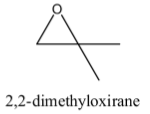
2, 2- Dimethyloxirane can be cleaved by:
(A) Acid
(B) Water
(C) Bromine
(D) None of these
Answer
216k+ views
Hint: The structure of 2, 2-dimethyloxirane contains a cyclopropane ring. 2, 2-Dimethyloxirane contains a heterocyclic ring in its structure. 2, 2-Dimethyloxirane also called as 1, 2-isobutylene oxide. The structure of 2, 2- Dimethyloxirane is as follows.

Complete step by step solution:-
-The ring strain is too high in cyclopropane rings when compared to cyclobutane, cyclopentane and cyclohexane.
-Because of ring strain in the structure of 2, 2-dimethyloxirane, it will undergo cleavage very easily.
-The cleavage of the 2, 2-dimethyloxirane is as follows.

-The mechanism of the cleavage of the 2, 2-dimethyloxirane is as follows.

-In the above mechanism we can see clearly that the ring cleavage is going to be initiated by an acid.
-In the first step the acid is going to form a bond with oxygen which is present in the ring and oxygen gets a positive charge because oxygen forms three bonds with the acid.
-Later the lone pair of electrons in the water molecule reacts with tertiary carbon atoms in the ring.
-Then the ring slowly destabilizes and the ring is going to cleave and forms an acyclic compound.
-Therefore the oxirane ring in 2, 2- dimethyloxirane is cleaved by the presence of an acid.
So, the correct option is A.
Note: Because of the presence of ring strain in the given molecule 2,2- dimethyloxirane, it undergoes ring cleavage easily with very small amounts of the acid. Cyclopropane has the highest strain in the ring of 114kJ/mol.

Complete step by step solution:-
-The ring strain is too high in cyclopropane rings when compared to cyclobutane, cyclopentane and cyclohexane.
-Because of ring strain in the structure of 2, 2-dimethyloxirane, it will undergo cleavage very easily.
-The cleavage of the 2, 2-dimethyloxirane is as follows.

-The mechanism of the cleavage of the 2, 2-dimethyloxirane is as follows.

-In the above mechanism we can see clearly that the ring cleavage is going to be initiated by an acid.
-In the first step the acid is going to form a bond with oxygen which is present in the ring and oxygen gets a positive charge because oxygen forms three bonds with the acid.
-Later the lone pair of electrons in the water molecule reacts with tertiary carbon atoms in the ring.
-Then the ring slowly destabilizes and the ring is going to cleave and forms an acyclic compound.
-Therefore the oxirane ring in 2, 2- dimethyloxirane is cleaved by the presence of an acid.
So, the correct option is A.
Note: Because of the presence of ring strain in the given molecule 2,2- dimethyloxirane, it undergoes ring cleavage easily with very small amounts of the acid. Cyclopropane has the highest strain in the ring of 114kJ/mol.
Recently Updated Pages
Difference Between Alcohol and Phenol: Structure, Tests & Uses

Classification of Drugs in Chemistry: Types, Examples & Exam Guide

JEE Atomic Structure and Chemical Bonding important Concepts and Tips

JEE Amino Acids and Peptides Important Concepts and Tips for Exam Preparation

Electricity and Magnetism Explained: Key Concepts & Applications

Chemical Properties of Hydrogen - Important Concepts for JEE Exam Preparation

Trending doubts
JEE Main 2026: Application Form Open, Exam Dates, Syllabus, Eligibility & Question Papers

Derivation of Equation of Trajectory Explained for Students

Hybridisation in Chemistry – Concept, Types & Applications

Understanding the Angle of Deviation in a Prism

Understanding Collisions: Types and Examples for Students

How to Convert a Galvanometer into an Ammeter or Voltmeter

Other Pages
NCERT Solutions For Class 12 Chemistry Chapter 1 Solutions - 2025-26

NCERT Solutions for Class 12 Chemistry Chapter Chapter 7 Alcohol Phenol and Ether

NCERT Solutions ForClass 12 Chemistry Chapter Chapter 8 Aldehydes Ketones And Carboxylic Acids

JEE Advanced Marks vs Ranks 2025: Understanding Category-wise Qualifying Marks and Previous Year Cut-offs

Haloalkanes and Haloarenes Class 12 Chemistry Chapter 6 CBSE Notes - 2025-26

Solutions Class 12 Chemistry Chapter 1 CBSE Notes - 2025-26




